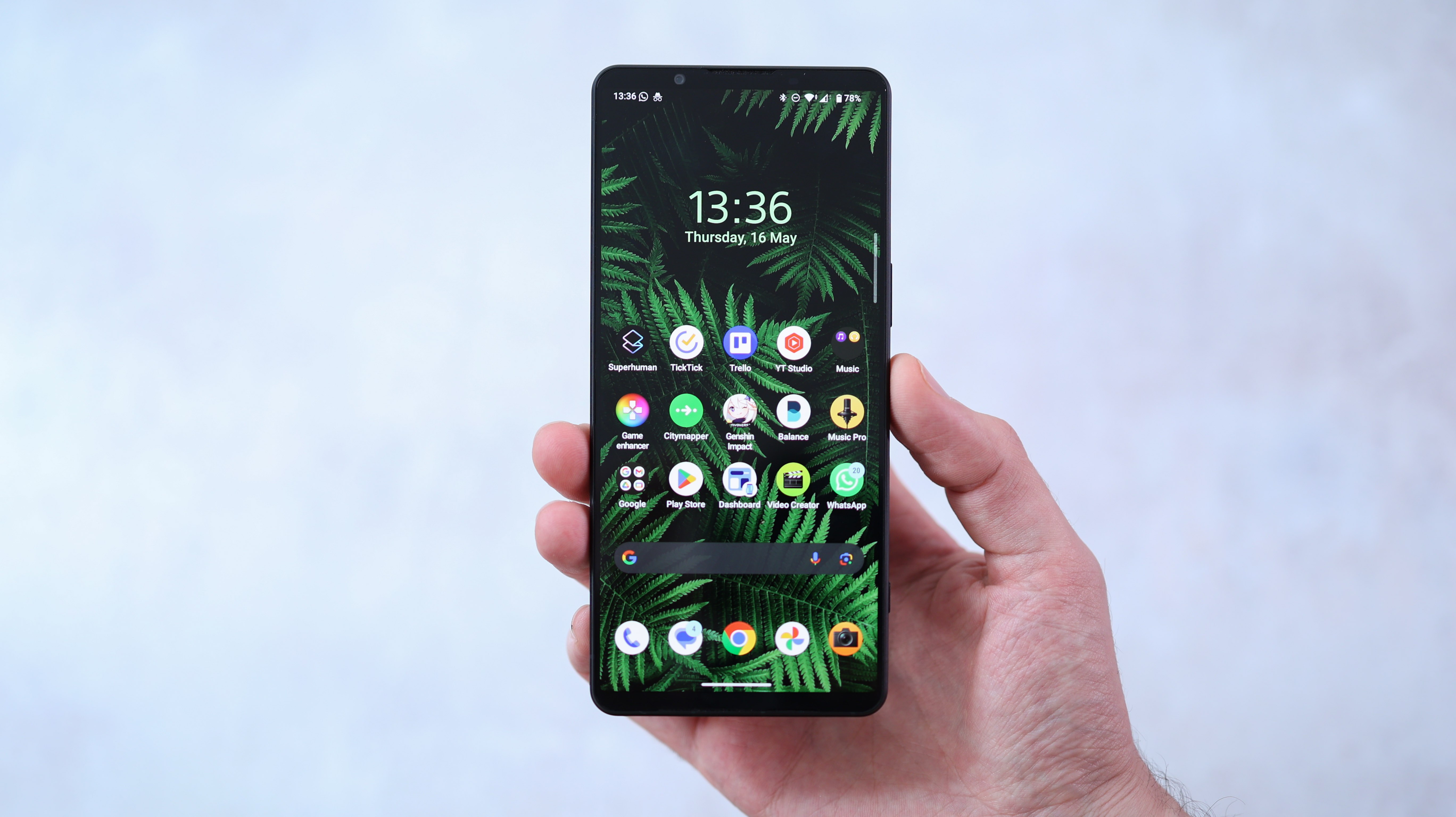
Sony's flagship Xperia 1 line has offered pro photo and video features and a 21:9 4K screen for years, but for its 2024 installment, the Xperia 1 VI, Sony has made an altogether more mainstream phone. While competitor devices like the Xiaomi 14 Ultra are leaning into advanced manual photo and video capture with variable apertures, 1-inch sensors and LOG mode, Sony seems to be playing it a bit safe with the Xperia 1 VI, at least on paper.
Costing £1,299, which is roughly $1,650 or AU$2470, the Sony Xperia 1 VI is significantly more expensive than an iPhone 15 Pro Max with the same 256GB storage.
When it comes to hardware, the main camera and ultra-wide are identical to those of the Xperia 1 VI, though Sony has extended the continuous zoom range to an impressive 85-170mm. Sony also ditched its three camera apps this year – Cinema Pro, Photo Pro, and Video Pro – and opted for a single all-in-one solution that's missing pro-grade video features until an Autumn update.
Even the Xperia 1 VI's screen spec is more pared back than its predecessor, with a FullHD+ panel instead of the 4K display Xperia 1 series phones have become known for. But is this mainstreaming a bad thing, and can Sony really command an asking price that makes the iPhone 15 Pro Max look affordable?

Sony Xperia 1 VI: design and screen
Unlike every other modern flagship smartphone, the Xperia 1 VI is loaded with traditional elements like a brilliant, spongy, and clicky two-stage camera button, a 3.5mm headphone jack, front-firing speakers, and a SIM card slot that can be removed with a fingernail – no fiddly pins required – plus microSD card expansion. These elements alone will make it an obvious choice for a certain type of user.
The main design difference between the 1 VI and past Sony phones is the screen aspect ratio, which has gone from 21:9 to 19.5:9. This makes the phone a little wider, a little shorter, and a little bit better for typing, watching, gaming, and capturing or editing photos.
Unlike the iPhone 15 Pro and Samsung Galaxy S24 Ultra, the Xperia 1 VI isn't made of titanium, but its metal frame nevertheless feels robust and premium. Textured sides give it some grip, and the matte glass back (also textured) feels great.

Sony was the first smartphone maker to add IP68 water resistance to its phones, and the Xperia 1 VI carries forward flagship durability with a Gorilla Glass Victus 2 display and a Gorilla Glass Victus back panel. The phone's camera bump is also very modest, especially when compared to alternatives like the Honor Magic 6 Pro and Vivo X100 Pro.
All the Xperia 1 VI's buttons are on the right side, with that excellent camera button, a fingerprint scanner/power button combo, and a volume rocker. At the top of the phone is the 3.5mm headphone jack, at the base is a USB-C port (with MHL/video out support), and the NFC point is around the back.
Available in three colors: black, Khaki Green, and Platinum Silver, Sony also sells matching kickstand cases for the Xperia 1 VI. However, the phone doesn't ship with a case or a pre-fitted screen protector, nor is there a charger or cable in the slimline, entirely recyclable box.


The Sony Xperia 1 VI's new 19.5:9 OLED screen measures 6.5 inches, and benefits from no notches or punch-hole selfie cameras. Instead, Sony puts the front camera and speakers in the bevels at the top and bottom of the display.
The move from 4K to Full HD is an interesting one. When we were briefed on the phone, Sony explained that the 4K panel prevented battery saving and brightness benefits the Full HD resolution makes possible. Side-by-side with an Xperia 1 V, the Xperia 1 VI does look less crisp when viewing pictures and 4K video content. However, the difference is imperceptible to the naked eye for day-to-day tasks.
There's no getting around the fact the Xperia 1 VI has the least sharp display of any modern-day flagship phone with 396 pixels in every inch. Most people won't notice this, especially since many elements within modern phones are rendered at Full HD, but if you know your eagle eye is a stickler for clarity, you might want to consider a sharper alternative like the OnePlus 12 or Google Pixel 8 Pro.
The 1 VI's display is optimized by Sony's Bravia division, is 50% brighter than last year's Xperia, and has a 1-120Hz adaptive refresh rate, a first for Sony. Outdoor viewing was great even on a sunny day, though the phone's auto-brightness does take a bit longer to adjust than other phones. The screen was also very responsive, and colors looked vibrant and punchy set against deep blacks and bright highlights.


Open the Xperia 1 VI's display settings and you can enable Creator Mode, which displays everything in a 10-bit BT.2020 color space, and customise white balance to suit your eyes.
Unless you plan to shoot in 21:9 (which the phone won't be able to do until autumn 2024), the new aspect ratio is a very good move in our opinion. In the past, when watching 16:9 YouTube videos in either portrait or landscape orientation, the tall 21:9 screens of Xperia phones of old had us squinting. Now, we have just a little bit more width when holding our phone in portrait, and a little bit less letterboxing when holding the phone in landscape.
Sony Xperia 1 VI: camera overview
The Sony Xperia 1 VI has three cameras around the back:
Ultra-wide: 16mm, f/2.2 lens with a 12MP 1/2.5-inch sensor.
Wide: 24mm, f1.9 lens with a 52MP (48MP effective) 1/1.35-inch sensor
Telephoto: 85-170mm, f/2.3-f/3.4 continuous zoom lens with a 12MP 1/3.5-inch sensor.
With its continuous zoom telephoto, you could argue that Sony's optical range gives you the benefits of quad-camera or penta-camera systems like that of the Xiaomi 14 Ultra.

24mm wide camera
Unlike the 1-inch sensor packing competition from Xiaomi and Vivo, the Xperia 1 VI has a 52MP 1/1.35-inch sensor. This isn't a normal 4:3 sensor – it features a 4.3:3 aspect ratio, slightly wider than a traditional camera to give more space for electronic stabilization in video, and it shoots 4:3 photos with a 48MP resolution, which is then pixel-binned down to 12MP.
As the full 52MP sensor is 1/1.35" and the phone captures stills at 48MP, that's an 8 percent reduction in utilized sensor for photos. In turn, relative sensor size is roughly 1/1.45". This isn't terrible, but neither is it class-leading, so we anticipate more modest dynamic range than 1-inch sensor competition.

16mm ultra-wide camera
While Xiaomi opts for a 12mm ultra-wide in its 14 Ultra and the Samsung Galaxy S24 Ultra has a 13mm equivalent focal length, the Xperia 1 VI's is a tight 16mm. This isn't particularly ultra-wide and adds modest value when the main camera has a 24mm angle of view while promising such superior picture quality given its spec. On the plus, the Xperia 1 VI ultra-wide does pack autofocus and can take impressive macro shots in bright environments.
85-170mm telephoto camera
Sony's showstopper camera on the Xperia 1 VI is the 85-170mm camera. Purely as a technological showcase, a continuous zoom periscope camera with this much reach and a wide f/2.3-f/3.4 aperture is impressive. The fact the camera also supports macro focus when set to 120mm, giving you manual focus as near as 4cm from a subject is the icing on the cake.
Considering competing periscope cameras tend to cap out at the 120mm mark, the fact Sony's goes further and does more is undoubtedly impressive.

As for the Sony camera app experience, three apps have been consolidated into one, and photographers won't mind as it retains plenty of manual control. Videographers who need more control than manual focus and shutter speed, however, probably will. Sony's pro-grade video features aren't available on the Xperia 1 VI on launch, with an update dropping in Autumn that will bring it nearer parity with past Xperias.
Sony Xperia 1 VI: camera performance
Typically, when the light is right, from 16mm through to 170mm and beyond, Sony delivers a reliable point-and-shoot experience.
Sony leans towards cooler tones than the competition. There is a bit of inconsistency in the white balance between lenses, and the phone does expose brightly, so the exposure slider in the camera interface is a great tool to dial things back. Sony's saturation isn't overly boosted and neither is contrast or sharpening when compared to Apple and Samsung.
While Sony has integrated some computational photography smarts in its auto processing, it's far less noticeable than the more HDR-heavy competition. This means you will have to tweak results to get anything close to a Google Pixel look from photos taken on the Xperia 1 VI. The need for edits won't appeal to typical smartphone users, but enthusiasts who love to take the reigns may appreciate it.




The new telephoto camera system is much better than that of the Xperia 1 V. Able to compete with the best out there right up to the 7.1x optical range, pair it with good light and/or a steady hand, and the results should impress.
Sony seems to not use AI zoom, which has become a popular tool used by brands like Asus, Honor and Samsung to clean up digital zoom shots. The result is softer images beyond the 7.1x optical zoom, especially given the 12MP resolution in the telephoto camera, leaving no scope for in-sensor cropping.
When the lights drop, the Xperia 1 VI's main camera can hold its own, however, the secondary cameras really struggle. This is where the Xperia 1 VI feels less like a robust system than the best from Xiaomi or Oppo for example. We appreciate that in order to keep its phones slim, Sony can't use massive sensors, but Xperias have started to fall behind at night, so this is something Sony needs to address in future either through more aggressive computational processing, or larger, better camera hardware.


The 48MP mode, new to the Xperia line, captures full-resolution JPGs, and they grab huge amounts of detail in bright environments. It would have been ideal if RAW photos could have been captured at full-resolution, but they are limited to 12MP.









The phone's party trick, its macro telephoto camera is a real highlight for photographers. While it can be finicky to capture stills owing to an incredibly shallow depth of field, the fact it records at 4K resolution up to 120fps means stills pulled from it look fantastic. The manual focus slider means you can manually rack focus in video, and it also means you can pinpoint focus for stills.
The Huawei P60 Pro and Xiaomi 13 Pro put telemacro on the map, with Huawei's efforts blowing us away when we tested its phone. The Xperia 1 VI brings Sony up to Huawei's level and beyond in some respects, especially when it comes to video. Our main gripe with Sony's macro shots is that they look a bit soft and need editing to crisp them up. Meanwhile, Huawei masterfully processes its macro shots to look as textured as possible, which makes for a more wow result out of the camera.



Despite the lack of pro-grade video capture, the Xperia 1 VI still impresses with its 4K footage across all cameras, and its rear cameras capping out at 120fps. Better still, with the continuous zoom, gliding between 85-170mm is buttery smooth, and the phone's stabilization is also good, especially from the main sensor.
There are some manual video tools. For example, you can adjust exposure, white balance (with a slider, not with Kelvin values), focus, and shutter speed. Sony's product showcase feature is also available on the rear camera, and subject tracking is excellent, as is eye AF. The 399 focus points when shooting with the main camera and physical camera button lock on quickly, but we do wish Sony included a zoom slider rather than just the on-screen zoom numbers.
Selfies are also respectable from the phone, and it's a boon that the front camera can shoot 4K video. Unfortunately, it lacks autofocus, a feature that would have paired well with the Product Showcase function.
Sony Xperia 1 VI: additional features
The Sony Xperia 1 VI's processor is a top-tier Qualcomm Snapdragon 8 Gen 3, matched with modest 256GB storage and a respectable 12GB RAM. With microSD card expansion, you can bump up the storage by 1.5TB at an additional cost, but SD storage isn't as fast, so it can result in slowdown unless you stump up for the nippiest storage around.
The side-mounted fingerprint scanner is responsive, and with a large 5,000 mAh battery that Sony states is made of a new, dense battery material, the phone lasts a very comfortable day when using it heavily – plenty of photography and video – and if you're going easy on it, you can get two days out of it, which is seriously impressive.
With 30W charging, the Xperia 1 VI powers up full in around 82 minutes, though can charge up by 50 percent in 22 minutes. Wireless charging is even slower, so Sony definitely isn't catering to anyone who needs to charge and dash.

Gaming on the Xperia 1 VI and general heat management was reliably good, with steady performance, modest throttling, and no overheating shutting down the camera in our time with it, unlike the 2022 Sony Xperia 1 IV.
The Xperia 1 VI runs Android 14 and promises three years of software updates and four years of security updates, which is up a year when compared to past Xperias but still falls behind Apple, Google, and Samsung by some margin.
Sony's interface is clean, smooth, and easy to navigate. It does feel a bit dated in some areas – very similar to past Xperias – but we'd take its dialed-down experience over an overbearing one like that of the Xiaomi 14 Ultra.

Sony Xperia 1 VI: verdict
Sony's flagship for 2024 is a great phone that's a joy to use with no major chinks in its armour beyond its price, but that is one big £1,299 chink.
The Xperia 1 VI could be the best phone for macro photography on the market, but it definitely isn't the best camera phone of 2024 given how fierce the competition is. In particular, the 1 VI's lowlight performance from the tele and ultra-wide cameras and the lack of pro video features hold it back, even with that super macro capture.
If the Sony Xperia 1 VI was less expensive, it would be a great option for anyone who wanted an impressive all-rounder. Photographers who love pared-back photo processing and want an excellent screen and speaker setup will enjoy what Sony's doing here too. It's also ideal for gaming and watching on, and Alpha camera owners who want a phone to double up as an external monitor and recorder may well find the price easier to swallow.
So while the Xperia 1 VI is the most accessible Sony phone of late with its more comfortable display, improved battery life, and simpler camera experience. Until Sony either bests the competition on spec and features or drops the price, its phones look set to remain niche options despite all their merits.







